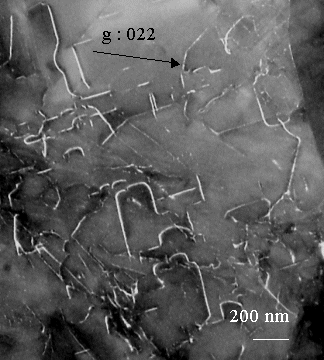

Mg2SiO4 ringwoodite was synthesised from a forsterite powder loaded in a rhenium capsule fitted in a 10/4 multianvil assembly and annealed for 240 min at 22 GPa and 1500-1700°C. After the run, the specimen was recovered and put in a second high-pressure (10/4) assembly designed to induce plastic deformation. Two deformation experiments have been performed: the first one run for 120 min at 22 GPa and 1000°C, the second one for 60 min at 22 GPa and 1400°C.
 |
Both samples show clear evidences for dislocation activity (Fig. 3.1-6). Dense deformation bands are more frequent in the sample deformed at 1000°C. In both cases, dislocations are in glide configurations. They show no evidence of climb structures nor dissociation. These microstructures are very similar to those observed in MgAl2O4 deformed at lower temperatures and lower strains.
The slip direction in the spinel structure is always observed to be parallel to <110>, i.e. 1/2<110> is the Burgers vector of the perfect dislocations. In our samples, the dislocations are found to glide in several planes: {111} and {110} (whatever the temperature of the experiment).

Tel: +49-(0) 921 55 3700 / 3766, Fax: +49-(0) 921 55 3769, E-mail: bayerisches.geoinstitut(at)uni-bayreuth.de
 Previous page
Previous page